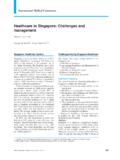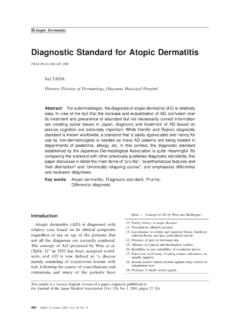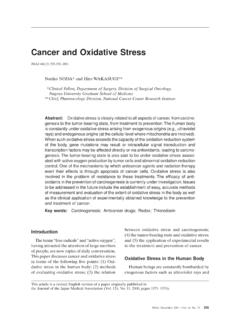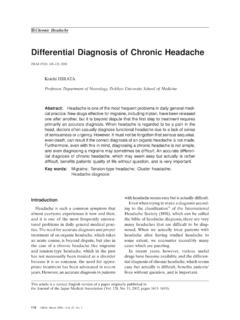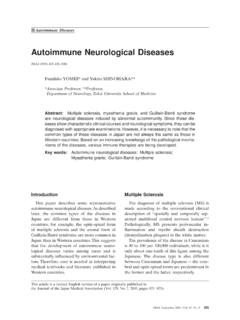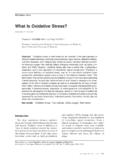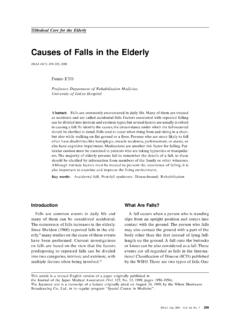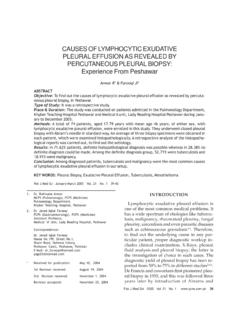Transcription of Differential Diagnosis of Pleural Effusions - Med
1 315 JMAJ, September / October 2006 Vol. 49, No. 9 10*1 Division of Respiratory Diseases, Department of Internal Medicine, Jikei University School of Medicine, TokyoCorrespondence to: Tetsuo Sato MD, PhD, Division of Respiratory Diseases, Department of Internal Medicine, Jikei University School ofMedicine, 3-25-8 Nishi-Shimbashi, Minato-ku, Tokyo 105-8461, Japan. Tel: 81-3-3433-1111, Fax: 81-3-3433-1020, E-mail: ArticleIntroductionA variety of disease states are associated with thedevelopment of Pleural Effusions (Table 1), anddepending on the disease, the Pleural effusion caneither exhibit specific or nonspecific characteris-tics. A Diagnosis of Pleural effusion may be sug-gested by characteristic symptoms ( , chest pain,dyspnea) and physical exam findings ( , dulllung bases on auscultation and percussion) butdefinitive Diagnosis requires radiological imag-ing.
2 In particular, X-rays taken with the patient inthe decubitus position have high diagnostic sensi-tivity, and computerized tomography imagingcan detect even small amounts of Pleural effusionand thus play a significant role in the assessmentof intrapulmonary and extrapulmonary ultrasound examination is another effec-tive method of confirming the presence of pleuralfluid and determining appropriate access sites forthoracentesis. Because intrapulmonary lesionscan go undetected when the Pleural Effusions arelarge, CT imaging should be repeated once thefluid has been drained. Further, special attentionshould be paid to the rate and volume of fluidaspiration during thoracentesis, as rapid or largevolume drainage may result in re-expansion pul-monary of Pleural EffusionsPleural fluid is continually secreted by bloodcapillaries in the visceral and parietal pleuralmembranes, but most of this fluid is normallysecreted from the parietal pleura.
3 Typically, theamount of fluid produced is equal to the amountreabsorbed by the flow of lymph from the visceralpleura. Consequently, the fluid keeps the pleuralsurface moist and reduces friction between thepleural membranes during respiratory excursionwithout accumulating in the Pleural cavity. Thisbalance between fluid production and absorptionDifferential Diagnosis of Pleural EffusionsJMAJ 49(9 10): 315 319, 2006 Tetsuo Sato*1 AbstractA variety of disease states are associated with the development of Pleural Effusions , which sometimes makes thedifferential Diagnosis problematic. Pleural Effusions can be classified into two categories, transudative andexudative, based on the characteristics of the Pleural fluid. While transudative Effusions are the result of changesin hydrostatic or oncotic pressure with no pathological change in the structure of the Pleural membrane orcondition of the vascular wall, exudative Effusions collect in the Pleural cavity as a result of pathological changesor structural breakdown of the pleura.
4 In recent years, Light s diagnostic criteria have been most commonly usedto differentiate between these two categories of Pleural effusion and to help delineate the underlying cause,including malignant tumors, infectious diseases (such as tuberculosis), collagen vascular disease, liver disease,pancreatic disease, iatrogenic causes, and gynecological diseases. Pleural mesothelioma secondary to asbestosexposure has been recognized as a cause of Pleural effusion , but diagnostic confirmation is difficult in somecases. When Pleural effusion cannot be controlled despite treatment of the underlying cause, pleurodesis can beperformed as a potentially permanent method of wordsPleura, effusion , Transudate, Exudate, Mesothelioma, Thoracentesis316 JMAJ, September / October 2006 Vol. 49, No. 9 10 Sato Tis maintained through multiple forces, includingplasma osmolality, hydrostatic pressure, venouspressure, and capillary wall transudate results from fluid that accu-mulates in the Pleural cavity as a result of abreakdown in the balance between Pleural fluidproduction and absorption in the context of anormal Pleural membrane, vascular wall, andlymphatic vessel structure.
5 For example, in somecases Pleural fluid accumulates as a result of anincrease in fluid production due to increases inhydrostatic pressure, reductions in oncotic pres-sure, or reductions in absorption. By contrast, anexudate results from fluid that accumulates in thepleural cavity as a result of structural breakdownor increased vascular permeability. In such cases,further tests are often necessary to determine theunderlying cause of this pathologic of Pleural FluidThe characteristics of Pleural fluid differ accord-ing to the underlying pathological condition butcan be broadly classified into two categories,transudative and exudative, and then further intosubcategories, such as purulent, bloody, and chy-lous, according to appearance and smell. Althoughthe classic Rivalta reaction can also be of assis-tance, Light s diagnostic criteria (Table 2) aremost commonly used to differentiate betweentransudative and exudative Effusions .
6 Accordingto this method, an exudative effusion is diagnosedif one or more of three criteria are the Pleural effusion is diagnosed as exu-date by this criterion in spite of clinically beingconsidered as transudate, the difference of albu-min concentration between serum and effusion isgreater than mg/dl, then the effusion is diag-nosed as transudate. The amount of LDH presentin the Pleural fluid is a rough indicator of theextent of Pleural inflammation and is usefulin assessing treatment outcomes. Transudativepleural fluid is often present in both sides of thechest and is caused by heart failure, nephroticsyndrome, low-protein leukemia, malnutrition,hypothyroidism, and other systemic 1 Causes of Pleural effusionsInfectious diseasesAll pneumonic Pleural inflammations, acute empyema, chronic empyema,tuberculosis pleuritis, parasitic infection (lung fluke, etc.)
7 Malignant tumorsPrimary lung cancer, metastatic lung cancer, thymoma ( Pleural metastasis, Pleural seeding), leukemia, Hodgkin s disease, multiple myeloma, malignantpleural mesotheliomaCollagen diseasesRheumatoid arthritis, SLE, Churg-Strauss syndromeGastrointestinal diseasesLiver cirrhosis, acute pancreatitis, liver abscess, subphrenic abscess,peritonitis, esophageal perforationCardiovascular diseasesCongestive heart failure, lung infarction, ruptured thoracic aortic aneurysm,Dressler syndromeRenal diseaseNephrotic syndromeGynecological diseasesMeigs syndrome, Pleural endometriosisIatrogenic diseasesDrugs, post-thoracic/abdominal surgery complications, radiationOtherExternal injury, spontaneous pneumothorax, benign asbestos pleurisy,sarcoidosis, yellow nail syndrome, pulmonary lymphangiomyomatosisTable 2 Light s criteria1. Ratio of Pleural fluid protein to total serum protein is or Ratio of Pleural fluid LDH to total serum LDH is or Pleural fluid LDH is two-thirds or more of the upper limit for serum , September / October 2006 Vol.
8 49, No. 9 10 Differential Diagnosis OF Pleural EFFUSIONSS ince the condition often resolves with treatmentof the underlying cause or with diuretics, thora-centesis is typically not required unless there isventilatory impairment or significant of Exudative EffusionsIn 25% of cases, Pleural effusion result frommalignant disease. In another 20 40% of cases,biochemical testing, bacteriological examination,and pathological cytology of the Pleural fluid failto identify any underlying cause of disease. Insuch cases, either cytology is repeated or a pleu-ral biopsy is tumorsWith malignant tumors, the Pleural effusion isoften bloody, but ordinary exudative pleuraleffusion is also possible. Malignant effusion canresult from primary cancer of the lungs, pleuralmesothelioma, leukemia, lymphoma, or meta-static spread of other tumors to the sensitivity of a single Pleural fluid cytol-ogy examination ranges from 40 80%; thus, inthe case of a negative result, the test should berepeated.
9 Pleural effusion is usually unilateral indistribution but can also be bilateral if effusionspreads to the contra lateral Pleural fluid CEA and other tumor markersare useful diagnostic adjuncts. When there is notumor detected in the lungs, metastasis fromother organs is suspected, and evaluation of thestomach, pancreas, large intestine, ovaries, andbreasts should be conducted to identify occulttumors. Indeed, in patients with a history ofbreast cancer, the disease can recur and manifestwith Pleural Effusions more than 10 years afterthe original cancer has been ostensibly cured. Inother cases in which adenocarcinoma cells arefound in the Pleural fluid without the identifica-tion of any primary tumor, the condition is oftendesignated as carcinomatous pleurisy resultingfrom primary lung 30 80% of patients with pleu-ral mesothelioma also have Pleural Effusions ,less than half of which are bloody.
10 In such cases,cytological Diagnosis is difficult, and detection ofelevated levels of Pleural fluid hyaluronic acid,which are caused by the accumulation of largeamounts of hyaluronic acid in mesothelial cells,may be necessary for correct Diagnosis . Mea-surement of serum mesothelin-related protein(SMRP) also has high specificity for a diagnosisof Pleural mesothelioma, but only a limited num-ber of facilities in Japan are able to perform diseasesTuberculous Pleural effusion is straw-coloredfluid contains fibrin and comprises approxi-mately 70% lymphocytes. The incidence of tuber-culous bacilli positive culture from Pleural fluidcultures is up to 20%, and the data of PCR testingis various results. A Pleural ADA of greater than50 IU/L is suggestive of tuberculosis, but pleuralADA can also be elevated in the context ofthoracic empyema, RA, and Hodgkin s fluid IFN levels may also be elevated inthe context of tuberculosis, but determination ofIFN levels is seldom Effusions secondary to bacte-rial pneumonia typically resolve with treatmentof the underlying pneumonia.
